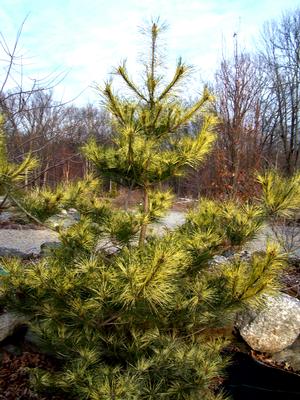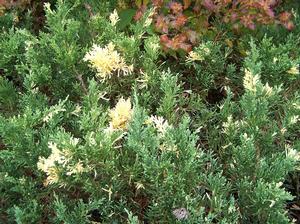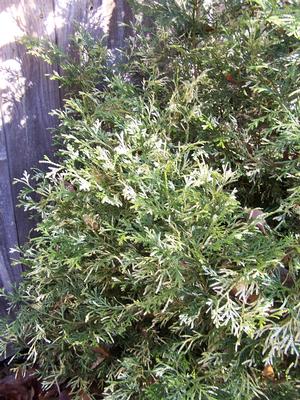
Pinus densiflora 'Oculus-draconis'

Juniperus davurica 'Expansa Aureo-spicata'

Thujopsis dolobrata 'Variegata'
Galaxies of Variegated Conifers
Speckles and splotches, spangles and spots: a celestial display studs the galaxy that is each variegated conifer. Some flaunt flecks of gold and silver. Some offer branch tips in yellow or white. Others are green banded with alternating gilded halos. There is a universe of heavenly variegated conifers from which to choose in this amazing new age of plant introductions.
Variegated conifers can be an important element in the microcosm of your backyard; that is, a well-placed variegated conifer used as a dynamic accent will add zest and life to a drab display. However, a word of caution: a little goes a long way. A dramatic accent can turn to comic relief with overuse. And yet, this may be the look you desire: a bright, breezy and fun collection around a child’s play house, for instance. But as a rule of thumb bear in mind that too many variegated accents can confuse the eye. Too many can jostle a calm psyche and rattle the brain. Plant them judiciously. Consider them as accents that will make a section of your landscape visually pop.
Following is a handful of stars in the cosmos of variegated conifers. I’ve made suggestions as to possible companions. This is merely to provide a platform from which to launch your own ideas. Zip up your space suits, don your helmets and let’s go for a ride!
Chamaecyparis pisifera ‘Mikko’ – Sawara Cypress. 'Mikko' translates from the Japanese to 'Snow'. This beautiful round globe with white tips over pea-sage green foliage is a sport of C. p. ‘Snow’. Found in 1991, ‘Mikko’ comes to us from Cedar Lodge Nursery in Plymouth, New Zealand. In a woodland garden that receives some morning sun and light afternoon shade or dappled light ‘Mikko’ would be handsome with Trillium erectum (Wakerobin), Syneilesis aconitifolia, Helleborus niger (Christman Rose) underplanted with an icy groundcover of Lamium maculatum ‘Pink Pewter’ (Dead Nettles).
Classification*: Dwarf
Height x Width: Undetermined but will grow 1 to 3 inches each year
Light: Part Shade
Soil: Moist, draining loam. Salt tolerance.
Zone: 4 to 8
Application: Conifer Collection, Foundation, Heath and Heather Border, Perennial Garden, Woodland Garden, Shrub Border, Labyrinth
Chamaecyparis pisifera ‘Silver Lode’ – Sawara Cypress. ‘Silver Lode’ forms a miniature flat bun. It is a sport of C. p. ‘Minima Aurea’ composed of gray-green foliage spangled with white flecks. Abstract your vision while gazing upon this lovely shrub and one might imagine a star-filled sky on a moonless night. 'Silver Lode’ will spread out into a beautiful ground cover. Plant a pool in front of Hypericum androsaemum ‘Albury Purple’ (St. Johnswort), Picea glauca ‘Jean’s Dilly’ (Dwarf White [Alberta] Spruce) and Miscanthus sinensis ‘Adagio’ (Dwarf Silver Grass).
Classification*: Miniature
Height x Width: 6 inches tall by 3 feet across
Light: Mostly Sun to Part Shade
Soil: Moisture retaining soil that drains well. Salt tolerance.
Zone: 4 to 8
Application: Groundcover, Conifer Collection, Foundation (front of the border), Shrub Border, (front of the border), Large Rock Garden
Cryptomeria japonica ‘Knaptonensis’ – Variegated Japnaese Cedar. This form, composed of juvenile foliage splashed with white, was discovered as a witch’s broom on C. j. ‘Argenteo-variegata’ in Switzerland, 1934. It develops into a low, broad and tight pyramid somewhat taller than wide. Use it in a part shade knot garden with Picea orientalis ‘Barnes’ (a dwarf Oriental Spruce), Buxus microphylla ‘Morris Dwarf’ (Korean Boxwood) and Berberis thunbergii ‘Bagatelle’ (a dwarf Purple Barberry) and/or Berberis thunbergii ‘Aurea’ (Gold Barberry). Protection from winter winds would benefit this little beauty.
Classification*: Dwarf
Height x Width: 14 inches tall by perhaps 10 to 12 across in 10 years
Light: Light to Dappled Shade
Soil: Moisture retentive soils that drain well
Zone: 5 to 8
Application: Dwarf Conifer Collection, Rock Garden (shaded), Heath and Heather Garden (afternoon shade), Perennial Garden, Miniature Railroad, Knot Garden, Labyrinth
Ginkgo biloba ‘Variegata’ – Maidenhair Tree. The variegated sport of Maidenhair Tree tends to be shrubby. Ginkgos are deciduous living fossils. And though not a conifer – it certainly does not bear cones, it is an ancient Gymnosperm and, therefore, a conifer precursor setting in a monotypic genus unto itself. The leaves are flat and broad like little fans which fall to the ground forming a beautiful golden blanket in the autumn. The fan shape is a modified needle. The common name refers to the fact that each lovely leaf resembles the individual leaflet of the Maidenhair Fern (Adiantum spp.) There are a number of clones under this moniker. All produce leaves which are irregularly streaked with creamy yellow, the patterns reminding me of northern lights. Arbor Village had been working to select better and more stable plants as many of the present selections revert easily. (Sadly, at the time of this update Arbor Village has now closed its doors.) But curiously a branch that is completely green one season may sprout nicely variegated foliage the next. It would be a standout in a mixed hedgerow with the rich dark green of Picea orientalis ‘Nana’ (Dwarf Oriental Spruce), a low-grafted Prunus ‘Snow Fountain’ (Snow Fountain Cherry) with the vertical accent of Pinus nigra ‘Arnold’s Sentinel’ (a columnar Austrian Pine).
Classification*: Dwarf to Intermediate, possibly Large depending on the clone
Height x Width: Undetermined, most are shrubby but this depends on the particular clone from which they come. Pruning may encourage more variegated foliage.
Light: Full Sun
Soil: Sandy, draining loams preferred but tolerant of a wide range of conditions
Zone: 4 to 8(9)
Application: Conifer Collection, Foundation (if pruned), Hedge, Mixed Hedgerow, Shrub Border, Bonsai
Juniperus chinensis ‘Kaizuka Variegated’ (syn. J. c. ‘Torulosa Variegata’) – Variegated Hollywood Juniper. This architectural specimen sports arms that extend upright and sometimes twist forming a shrub of great character. Rich green foliage splashed with creamy white at branch tips like little solar flares cloaks a very picturesque plant. It grows slower and much smaller than its solid green sister, ‘Kaizuka’, which in California can attain heights of 30 feet give or take. But for us ‘Kaizuka Variegated’ develops into a narrow and irregular upright shrub of about 6 feet in a dozen years. The Variegated Hollywood Juniper would be beautiful with Rhododendron x ‘Percy Wiseman’, Ilex verticillata ‘Red Sprite’ (Dwarf Winterberry), foreplanted with Erica carnea ‘Springwood White’ (Heath) in a section of a larger island garden.
Classification*: Intermediate
Height x Width: Maybe 6 feet tall by 2 to 2 ½ feet across in 10 to 12 years
Light: Full Sun
Soil: Moisture retaining but draining soils. Drought, heat and salt tolerance.
Zone: 4 to 8(9)
Application: Conifer Collection, Foundation (between windows), Mixed Hedgerow, Heath and Heather Border (vertical accent), Perennial Garden (anchor, specimen), Shrub Border
Pinus densiflora ‘Oculus-draconis’ – Dragon’s Eye Japanese Red Pine. The famous Dragon’s Eye Pine holds long green needles alternating with broad bands of creamy yellow like halos within halos. When looking head-on into the tip of a branch the circles of variegation imaginatively resemble dragons eyes. This special Japanese Red Pine is striking and beautiful in all seasons growing into an upright to irregular pyramid. The bark is red-brown and flakes in patches. It is beautiful and certainly the reason for the common name, Japanese Red Pine. Plant one near Chamaecyparis obtusa ‘Kosteri’ (Japanese Hinoki Cypress) and Acer palmatum ‘Oshu Beni’, an orange-red Japanese Maple with bright red fall color.
Classification*: Intermediate to Large
Height x Width: 8 feet tall in 10 years
Light: Full Sun to Part Shade
Soil: Moisture retaining but draining acid soils
Zone: 3b to 7
Application: Large Conifer Collection, Specimen, Allee, Mixed Hedgerow, Shrub Border (anchor)
Pinus parviflora ‘Ogon-janome’ – Japanese White Pine. This rare plant is also called a “Dragon’s Eye Pine”. This nomenclature illustrates the problem and confusion that sometimes comes with common names. This extraordinary variant of Japanese White Pine is smaller in all respects to its cousin, Pinus densiflora ‘Oculis-draconis’. The needles are short and banded with bright warm yellow auras on a small mounding shrub. It is difficult to propagate and therefore not common in the trade. But if you run across one, nab it, for it is a great treasure. For four season interest it would be lovely with companions such as Rhododendron ‘Black Satin’, and Vaccinium angustifolium ‘Burgundy’ (Low-bush Blueberry), Andromeda polifolia ‘Blue Ice’ (Bog Rosemary) with Vaccinium macrocarpum ‘Hamilton’ (Dwarf Cranberry) in the foreground.
Classification*: Miniature to Dwarf
Height x Width: 3 feet tall by 3 feet across in 15 years. 'Ogon-janome' will eventually form a leader and become a gorgeous upright pyramid.
Light: Full Sun
Soil: Best in a light well-draining acid soil. Salt tolerance.
Zone: 4 to 7
Application: Conifer Collection, Large Rock Garden, Foundation, Heath and Heather Border, Perennial Garden, Shrub Border
Pinus wallichiana ‘Zebrina’ – Himalayan Pine. Multitudes of long, thin yellow-banded needles cloak this gorgeous pine. The elegant upright pyramid will develop into a very bright and graceful spot in the landscape. I see this gentle beauty best used as a specimen. It will bring great pleasure in all seasons but especially in winter when the glow of its soft, variegated needles will be most apparent.
Classification*: Intermediate
Height x Width: 8 feet tall by 4 feet across in 10 to 12 years
Light: Full Sun to ¼ Shade
Soil: Fertile, moisture retaining acid soils
Zone: 5 to 7
Application: Conifer Collection, Specimen, Shrub Border, Mixed Hedgerow
Thuja occidentalis ‘Wansdyke Silver – American Arborvitae. This beautiful Thuja develops into a tight upright cone. A profusion of creamy white “stars” adorns a rich, deep green backdrop. In a sunny perennial garden it could make a strong anchor for Leucanthemum ‘Sonnenschein’ (a new Shasta Daisy with creamy yellow flowers), Campanula carpatica ‘White Clips’ (Bellflower) with a touch of raspberry as found in Lychnis coronaria (Rose Campion).
Classification*: Dwarf to Intermediate
Height x Width: eventually a large upright pyramid, 20 feet guessing
Light: Full Sun
Soil: Fertile, moisture retaining acid soils
Zone: 3 to 7
Application: Dwarf Conifer Collection, Foundation, Heath and Heather Border, Perennial Garden, Shrub Border, Formal Garden (small element), Knot Garden, Labyrinth, Screen
Thujopsis dolobrata ‘Variegata’ – Japanese Elk Horn Cedar or Japanese Deer Horn Cedar. The large sprays, each reminiscent of an enlarged flattened spray of Arbovitaae, are rich dark green with splotches of silvery white. Phillip von Siebold, a plant explorer extraordinaire, brought it to Holland from Japan in 1859. It will benefit in a sheltered environment protected from drying winds especially in winter. Though I have not heard of Japanese Elk Horn Cedar used formally I expect it would likely take reasonably well to pruning. As such in a less than traditional formal garden it could make an unusual large variegated element. If allowed to do what this magnificent shrub does naturally it would hide an unwanted view with beauty and grace.
Classification*: Large
Height x Width: 30 feet tall by 10 to 20 feet across at maturity
Light: Part Shade
Soil: Moisture retaining organic soils
Zone: 5 to 7
Application: Large Conifer Collection, Hedge (if sheltered), Mixed Hedgerow, Screen, Formal Garden and Maze(possibly), Large Woodland Garden
Tsuga canadensis ‘Gentsch White’ – Canadian Hemlock. White foliage for several inches at the tips of branches over a dark rich green interior gives this lovely Hemlock a cool, frosted appearance that glows in shady spots. Pruning will encourage even more white new growth. Otto Gentsch of Long Island, New York found this wonderful shrub. It could make a beautiful clipped labyrinth circle. ‘Gentsch White’ is resplendent in a woodland setting with Hosta ‘Blue Cup’, Kalmia angustifolia f. candida (White Sheep Laurel), Arisaema triphyllum (Jack-in-the-Pulpit) and Athyrium filix femina x niponicum ‘Branford Beauty’ (Branford Beauty Fern). 'Moonfrost', another striking variegated Canadian Hemlock, often displays even more milk-white foliage on a miniature to dwarf selection remaining smaller than 'Gentsch White'. 'Moonfrost' tends to remain a rounded to mounding shrub and if pruned would be magnificent in a trough or even used for bonsai.
Classification*: Dwarf
Height x Width: 3 ½ feet tall by 3 ½ feet across in 12 to 15 years
Light: Part to Light Shade
Soil: Moisture retaining acid and humus-laden soils
Zone: 3b to to 6(7)
Application: Large Shady Rock Garden, Foundation, Conifer Collection, Mixed Hedgerow, Woodland Garden, Shaded Shrub Border, Formal Garden, Labyrinth
With flecks and stars of silver in some, nebulae of splashed creamy gold in others variegated conifers make beautiful contrasting statements among solid-colored neighbors. One well-placed specimen will enliven a landscape, guaranteed. So, consider dressing-up that drab section of your garden in sun of shade. Be imaginative. Have fun. After all, you are the gods and goddesses of your landscapes. You have the power to move galaxies!
- Miniature: up to 1 inch per year. Estimated size in 10 to 12 years is about 1 foot.
-
Dwarf: average rate of 1+ to 6 inches per year. Estimated size in 10 to 12 years is 1+ foot to 6 feet.
-
Intermediate: average rate of 6 to 12 inches per year. Estimated size in 10 to 12 years is 6 to 12 feet.
-
Large: average rate of 12 or more inches per year. Estimated size in 10 to 12 years is 12 feet or more.
Penned by Wayne Paquette, January 2006